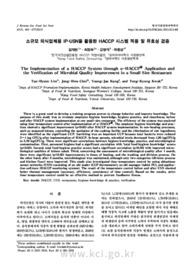

PARTNER
검증된 파트너 제휴사 자료
소규모 외식업체용 IP-USN을 활용한 HACCP 시스템 적용 및 유효성 검증 (The Implementation of a HACCP System through u-HACCPⓇ Application and the Verification of Microbial Quality Improvement in a Small Size Restaurant)
14 페이지
최초등록일 2025.06.08
최종저작일
2013.03

-
미리보기
서지정보
· 발행기관 : 한국식품영양과학회
· 수록지 정보 : 한국식품영양과학회지 / 42권 / 3호 / 464 ~ 477페이지
· 저자명 : 임태현, 최정화, 강영재, 곽동경
초록
There is a great need to develop a training program proven to change behavior and improve knowledge. The purpose of this study was to evaluate employee hygiene knowledge, hygiene practice, and cleanliness, before and after HACCP system implementation at one small-size restaurant. The efficiency of the system was analyzed using time-temperature control after implementation of u-HACCPⓇ. The employee hygiene knowledge and practices showed a significant improvement (p<0.05) after HACCP system implementation. In non-heating processes, such as seasoned lettuce, controlling the sanitation of the cooking facility and the chlorination of raw ingredients were identified as the significant CCP. Sanitizing was an important CCP because total bacteria were reduced 2~4 log CFU/g after implementation of HACCP. In bean sprouts, microbial levels decreased from 4.20 logCFU/g to 3.26 logCFU/g. There were significant correlations between hygiene knowledge, practice, and microbiological contamination. First, personnel hygiene had a significant correlation with ‘total food hygiene knowledge’ scores (p<0.05). Second, total food hygiene practice scores had a significant correlation (p<0.05) with improved microbiological qualities of lettuce salad. Third, concerning the assessment of microbiological quality after 1 month, there were significant (p<0.05) improvements in times of heating, and the washing and division process. On the other hand, after 2 months, microbiological was maintained, although only two categories (division process and kitchen floor) were improved. This study also investigated time-temperature control by using ubiquitous sensor networks (USN) consisting of an ubi reader (CCP thermometer), an ubi manager (tablet PC), and application software (HACCP monitoring system). The result of the temperature control before and after USN showed better thermal management (accuracy, efficiency, consistency of time control). Based on the results, strict time-temperature control could be an effective method to prevent foodborne illness.영어초록
There is a great need to develop a training program proven to change behavior and improve knowledge. The purpose of this study was to evaluate employee hygiene knowledge, hygiene practice, and cleanliness, before and after HACCP system implementation at one small-size restaurant. The efficiency of the system was analyzed using time-temperature control after implementation of u-HACCPⓇ. The employee hygiene knowledge and practices showed a significant improvement (p<0.05) after HACCP system implementation. In non-heating processes, such as seasoned lettuce, controlling the sanitation of the cooking facility and the chlorination of raw ingredients were identified as the significant CCP. Sanitizing was an important CCP because total bacteria were reduced 2~4 log CFU/g after implementation of HACCP. In bean sprouts, microbial levels decreased from 4.20 logCFU/g to 3.26 logCFU/g. There were significant correlations between hygiene knowledge, practice, and microbiological contamination. First, personnel hygiene had a significant correlation with ‘total food hygiene knowledge’ scores (p<0.05). Second, total food hygiene practice scores had a significant correlation (p<0.05) with improved microbiological qualities of lettuce salad. Third, concerning the assessment of microbiological quality after 1 month, there were significant (p<0.05) improvements in times of heating, and the washing and division process. On the other hand, after 2 months, microbiological was maintained, although only two categories (division process and kitchen floor) were improved. This study also investigated time-temperature control by using ubiquitous sensor networks (USN) consisting of an ubi reader (CCP thermometer), an ubi manager (tablet PC), and application software (HACCP monitoring system). The result of the temperature control before and after USN showed better thermal management (accuracy, efficiency, consistency of time control). Based on the results, strict time-temperature control could be an effective method to prevent foodborne illness.참고자료
· 없음태그
-
자주묻는질문의 답변을 확인해 주세요

꼭 알아주세요
-
자료의 정보 및 내용의 진실성에 대하여 해피캠퍼스는 보증하지 않으며, 해당 정보 및 게시물 저작권과 기타 법적 책임은 자료 등록자에게 있습니다.
자료 및 게시물 내용의 불법적 이용, 무단 전재∙배포는 금지되어 있습니다.
저작권침해, 명예훼손 등 분쟁 요소 발견 시 고객센터의 저작권침해 신고센터를 이용해 주시기 바랍니다. -
해피캠퍼스는 구매자와 판매자 모두가 만족하는 서비스가 되도록 노력하고 있으며, 아래의 4가지 자료환불 조건을 꼭 확인해주시기 바랍니다.
파일오류 중복자료 저작권 없음 설명과 실제 내용 불일치 파일의 다운로드가 제대로 되지 않거나 파일형식에 맞는 프로그램으로 정상 작동하지 않는 경우 다른 자료와 70% 이상 내용이 일치하는 경우 (중복임을 확인할 수 있는 근거 필요함) 인터넷의 다른 사이트, 연구기관, 학교, 서적 등의 자료를 도용한 경우 자료의 설명과 실제 자료의 내용이 일치하지 않는 경우
“한국식품영양과학회지”의 다른 논문도 확인해 보세요!
-
Vibrio sp. PKA 1003의 알긴산 분해 조효소 생산 최적 조건과 조효소의 특성 7 페이지
This study was conducted to screen the characteristics and alginate-degrading activity of marine bacterium isolated from brown seaweed (Sargassum thunbergii). The results of 16S ribosomal RNA sequence.. -
한국산 고구마잎과 고구마줄기 에탄올 추출물의 in vitro 항산화, 항알레르기 및 항염증효과 9 페이지
In order to increase the utilization of sweet potato leaves and stalks as much as roots, it is necessary to study their beneficial potential. In this study, the antioxidant, antiallergic and anti-infl.. -
메타세콰이어나무 열매와 잎의 영양성분 및 항산화 활성 6 페이지
The nutrients and antioxidative activities of fruits and leaves from Metasequoia glyptostroboides were investigated to provide basic data for the future development of functional foods. The nitrogen-f.. -
수분주입량에 따른 압출성형 옥수수 섬유질의 물리화학적 특성 7 페이지
This study was designed to examine changes in the physicochemical properties of extruded corn fibers with different amounts of feed moisture (30, 40, and 50%). The screw speed and die temperature were.. -
CHP(Cyclo His-Pro) 함유 대두가수분해물을 이용한 코팅 쌀의 제조 6 페이지
A method for coating rice with a novel substance, SHC [soybean hydrolysate with Cyclo Histidine-Proline (CHP)], was developed to produce functional rice for food production. The dip coating and spray ..
문서 초안을 생성해주는 EasyAI
